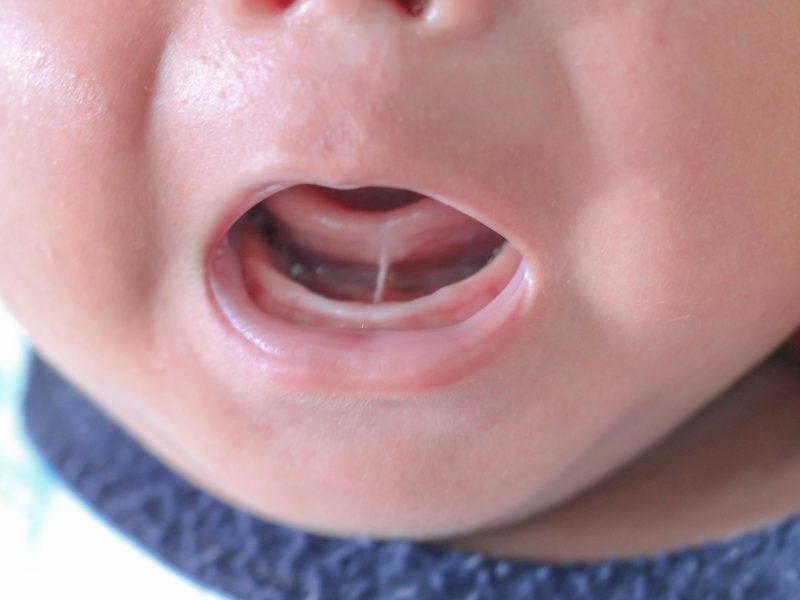Tongue-tie in babies is a common condition that many parents face, often without realising it. This simple guide will help you understand what it is, how to spot it, and the treatment options available. Our Brisbane paediatric dentist specialises in caring for young patients with this condition, ensuring they receive the best possible care. By reading on, you’ll gain valuable insights into how tongue-tie might be affecting your child and what you can do to help.

What is Tongue-Tie?
Tongue-tie is a common condition that some babies are born with, where a tight strip of tissue under their tongue limits movement more than usual. This band of tissue, called the lingual frenulum, connects the bottom of the tongue to the floor of the mouth. When it’s shorter or tighter than normal, it can hold the tongue too tightly. This can make it hard for the baby to move their tongue freely.
This limitation can affect how a baby eats and, later on, how they talk. It’s often spotted when parents notice their baby has trouble breastfeeding, as a good latch requires the baby to move their tongue over the lower gum. Tongue-tie doesn’t always need treatment, but if it’s causing problems with feeding or if it might affect speech later on, there are simple procedures available to correct it. These treatments help the tongue move more freely, making eating and speaking easier as the child grows.
How Can I Tell if My Child Has Tongue-Tie?
Identifying tongue-tie in your child early can make a significant difference in their feeding and speech development. Here are clear signs to watch for:
- Difficulty Lifting the Tongue: If your child struggles to lift their tongue towards their upper teeth, it might be restricted by a tight lingual frenulum.
- Limited Side-to-Side Tongue Movement: A baby with a tongue-tie may not be able to move their tongue from one side of their mouth to the other.
- Heart-Shaped Tongue Tip: When your child tries to stick out their tongue, look for a distinctive heart shape at the tip, which indicates that the middle is being pulled back by the frenulum.
- Trouble with Breastfeeding: If your child has difficulties latching on or stays on the breast for a very long time only to seem hungry soon after, this might be due to limited tongue movement.
If you notice any of these signs, it’s a good idea to consult with a kids’ dentist or a doctor who specialises in treating tongue-tie. They can provide a proper diagnosis and discuss possible treatment options to help your child thrive.
What Problems Can Tongue-Tie Cause?
Tongue-tie can affect a child in several key areas, particularly during the early stages of development. Here are the common issues it can cause:
- Breastfeeding Difficulties: Tongue-tie restricts the baby’s ability to latch effectively. This can lead to inadequate feeding, frustration at the breast, and significant discomfort for the mother, including sore or cracked nipples.
- Speech Problems: As children grow, tongue-tie might hinder their ability to pronounce certain sounds correctly. Sounds that require the tongue to reach the roof of the mouth, such as “t,” “d,” “l,” and “n,” can be particularly challenging.
- Dental Issues: Limited tongue movement can prevent the natural cleaning of the mouth by the tongue, which helps in sweeping away food particles. This may contribute to tooth decay and gum disease. Additionally, tongue-tie may lead to a gap between the front bottom teeth.
- Poor Oral Hygiene: Restricted movement of the tongue may make it difficult to manage oral hygiene effectively. Children might struggle with brushing their teeth thoroughly, which increases the risk of oral health problems.
- Challenges with Eating: Tongue-tie can make it tough for children to eat certain textures or types of food. They might have difficulty moving food around in the mouth, which is essential for chewing and swallowing efficiently.
Addressing tongue-tie early with appropriate medical interventions can help mitigate these problems, improving the child’s quality of life and development. If you suspect your child may have tongue-tie, consulting a specialist who can offer a proper diagnosis and suitable treatment options is crucial.
How Does Tongue-Tie Affect Breastfeeding?
Tongue-tie can significantly impact breastfeeding, making it a challenging experience for both mother and baby. Here’s how it affects the process:
- Difficulty Latching: The restricted movement of the tongue makes it hard for the baby to latch deeply and securely. This can result in a shallow latch where the baby grips the nipple instead of the breast, leading to ineffective feeding.
- Poor Feeding: Due to the inability to latch well, babies with tongue-tie might not be able to suckle effectively. This can lead to insufficient milk intake, which might cause slow weight gain and dissatisfaction for the baby.
- Prolonged Feeding Times: Babies struggling with tongue-tie often stay on the breast longer because they cannot extract milk efficiently. This can be exhausting for both the mother and the baby.
- Nipple Pain and Damage: A poor latch is not only ineffective but can also cause significant nipple pain and trauma, including cracking, bruising, and bleeding of the nipples, which can be quite painful for the mother.
- Increased Frustration and Anxiety: These feeding challenges can lead to increased stress and anxiety for the mother, which might impact her milk supply and overall postpartum recovery.
Understanding these challenges is crucial. If you notice any of these signs while breastfeeding, it’s advisable to consult a healthcare provider who can assess for tongue-tie and discuss potential treatment options to improve the breastfeeding experience.
Can Tongue-Tie Affect My Child’s Speech?
Tongue-tie can impact a child’s ability to speak clearly. Here’s how it affects speech development:
- Limited Tongue Movement: Tongue-tie restricts the tongue from reaching the high and back parts of the mouth, which is crucial for making certain sounds.
- Articulation Issues: Due to limited movement, children with tongue-tie often have trouble pronouncing sounds that require the tongue to touch the roof of the mouth, like “t,” “d,” “n,” and “l.”
- Delayed Speech Development: Children might develop speech later than usual as they struggle with the physical limitations of tongue-tie.
- Frustration and Communication: Difficulty in speaking can lead to frustration for the child, which might affect their communication and social skills.
- Long-Term Speech Issues: If not addressed, tongue-tie can lead to persistent articulation problems that might require speech therapy even after the physical condition is treated.
Recognising these potential issues early and consulting with a healthcare provider can lead to appropriate interventions, such as a simple procedure to release the tongue-tie or speech therapy to help correct articulation difficulties. This proactive approach helps ensure that tongue-tie does not hold back a child’s ability to communicate effectively.
At What Age Should Tongue-Tie Be Treated?
Deciding when to treat tongue-tie depends largely on the problems it causes. It’s often best to treat it early if you notice issues that affect your child’s ability to feed or potentially their future ability to speak. Here’s a clear guide on when to consider treatment:
- Early Months: If tongue-tie is hindering breastfeeding, causing pain for the mother or poor feeding for the baby, early treatment can be beneficial. Addressing tongue-tie in the first weeks or months can drastically improve feeding outcomes and comfort for both mother and baby.
- Monitoring and Assessment: In cases where tongue-tie isn’t immediately causing problems, regular check-ups can help monitor any emerging issues related to speech or oral development. Some children may display symptoms only as they grow older and start speaking more.
- Before Speech Development: If there are no immediate breastfeeding issues, consider evaluation before the child begins to speak. This proactive approach can prevent speech difficulties that may be harder to correct later on.
- On a Need Basis: For some, tongue-tie may never cause significant problems and might not require treatment. However, if challenges with eating, dental hygiene, or speech clarity arise, consulting with a specialist can determine if treatment is necessary.
In summary, while tongue-tie can be treated at any age, addressing it early can prevent a range of complications and support smoother development in feeding and speech. If you suspect your child has tongue-tie, a consultation with a kids dentist can provide guidance tailored to your child’s needs.

Is Tongue-Tie Hereditary?
Tongue-tie may have a hereditary component, suggesting that it can run in families. If one family member has been diagnosed with tongue-tie, it increases the likelihood of the condition appearing in new family members. Healthcare providers often consider family history when assessing a child for tongue-tie, particularly if there are known issues such as difficulties with breastfeeding, speech, or dental problems within the family. Research supports the genetic links, identifying specific genes that influence the development of the lingual frenulum, the tissue connecting the underside of the tongue to the floor of the mouth.
For families with a history of tongue-tie, monitoring newborns for signs of the condition is crucial. Early diagnosis and treatment can help mitigate potential complications with feeding and speech development, ensuring children receive the necessary care early on. If there is a history of tongue-tie in your family, discussing this with your healthcare provider during prenatal visits is an important part of your care plan.
What Are the Treatment Options for Tongue-Tie?
When addressing tongue-tie in babies, two primary treatment options are considered based on the severity and specific needs of the child:
Frenotomy
Procedure: This is a quick and straightforward procedure where a trained doctor or dentist snips the tight frenulum under the tongue with sterile scissors or a laser. This release often requires no anaesthesia in infants and is over within seconds.
Recovery: Post-procedure discomfort is minimal, and babies can usually breastfeed almost immediately, which helps in healing. The simplicity of the procedure means it’s often performed in the doctor’s office with immediate return to normal activities.
Frenuloplasty
Procedure: Recommended for more severe cases or when additional tissue needs repair, a frenuloplasty involves a more detailed surgical release of the tongue-tie. This procedure may involve sutures to optimise healing and reshaping of the tongue’s mobility.
Recovery: This surgery usually requires local anaesthesia and sometimes sedation, depending on the patient’s age and needs. Post-operative care includes pain management and exercises to prevent reattachment of the frenulum as the wound heals.
The choice of procedure depends on the severity of the tongue-tie and the child’s specific needs. Consulting with a specialist is crucial to determine the best treatment path. Follow-up visits are essential to monitor healing and ensure proper tongue function. If issues continue, further therapies like speech therapy may be necessary.
Is the Procedure to Correct Tongue-Tie Painful?
Correcting tongue-tie varies in discomfort depending on the age of the patient and the type of procedure performed. In infants, a frenotomy, which involves a quick snip of the frenulum, is generally well-tolerated and causes minimal discomfort. This procedure is so brief that it often doesn’t require any anaesthesia, and babies can usually breastfeed almost immediately afterwards.
For older children and adults, the procedure, typically a frenuloplasty, can be more involved and might require local anaesthesia. This procedure not only cuts the frenulum but may also involve stitches to ensure proper healing, which can lead to more discomfort and a longer recovery period than the simpler frenotomy. The discomfort and recovery time are generally manageable with appropriate pain relief and care, and the long-term benefits in terms of improved tongue mobility and function can be significant.
What Should I Expect After the Tongue-Tie Procedure?
After a tongue-tie procedure, whether it’s a frenotomy or a frenuloplasty, the recovery experiences can differ based on the age of the patient and the complexity of the procedure. Here’s what you can generally expect:
Infants
Immediate Feeding: Most babies are able to breastfeed almost right after a frenotomy, which helps with healing.
Minor Discomfort: It’s common for infants to show some fussiness and minor bleeding, but this usually resolves quickly.
Quick Recovery: Recovery for infants is typically swift, with minimal intervention required.
Older Children and Adults
Soreness: More discomfort is expected due to the more invasive nature of frenuloplasty, which may involve stitches.
Post-operative Care: It’s crucial to follow specific care instructions from the healthcare provider to ensure proper healing. This may include pain management and oral exercises.
Longer Recovery Period: Healing takes longer and might require follow-up visits to ensure everything is healing well and to assess the need for further treatment such as speech therapy.
Both procedures aim to significantly improve the quality of life related to feeding, speech, and oral hygiene, and it’s important to closely monitor the recovery to address any concerns promptly.
Are There Any Risks Associated with Tongue-Tie Procedures?
Tongue-tie procedures are generally safe, but like any medical intervention, they may carry some risks. Here’s what to consider:
- Bleeding: While usually minor, bleeding is a common risk immediately following the procedure, especially in more invasive treatments like a frenuloplasty.
- Infection: As with any procedure that involves a cut or incision, there’s a risk of infection. However, the risk is low if proper sterile techniques are used and post-operative care instructions are followed.
- Scar Tissue Formation: There’s a possibility of scar tissue developing at the site of the cut, which could lead to re-tethering of the tongue and potentially necessitate further treatment.
- Pain and Discomfort: Some pain and discomfort are expected, especially in older children and adults, as the area heals.
To minimise these risks, it’s important to follow all aftercare instructions provided by your healthcare provider. Additionally, maintaining good oral hygiene and attending follow-up appointments are crucial to ensuring the best outcome from the procedure.
How Can I Help My Child After Tongue-Tie Treatment?
After your child undergoes a tongue-tie treatment, there are several steps you can take to help them recover smoothly and effectively. Here’s what you can do:
- Follow Care Instructions: Adhere strictly to the care instructions provided by your healthcare provider. These may include how to clean the area and any signs of infection to watch for.
- Pain Management: If your child experiences discomfort, use pain relief methods as advised by your healthcare provider. For infants, this might include cold teething rings or pain relief medication recommended by a paediatrician.
- Feeding Support: For infants, monitor breastfeeding closely to ensure the baby is latching well post-procedure. If you encounter difficulties, consider consulting a lactation consultant.
- Encourage Proper Tongue Movement: Engage your child in exercises that promote tongue mobility. These exercises are particularly important in the days following the procedure to prevent the frenulum from reattaching.
- Observe Speech Development: As your child grows, pay attention to their speech development. If you notice any delays or difficulties, consider consulting a speech therapist to ensure that tongue mobility issues are addressed.
- Regular Check-Ups: Schedule follow-up appointments with your dentist or healthcare provider to monitor the healing process and confirm the success of the treatment.
Supporting your child through these steps will help ensure a quick recovery and optimal outcome from their tongue-tie treatment.

Can Tongue-Tie Recur After Treatment?
After treatment for tongue-tie, recurrence is possible but relatively rare. Here are key points to understand about the possibility of tongue-tie reattaching and how to manage it:
- Reattachment Risk: The frenulum, the tissue that was cut during the procedure, may, in some cases, grow back and cause the tongue to be restricted again, particularly if the initial cut doesn’t heal properly or fully.
- Importance of Follow-up: Regular follow-up visits with your healthcare provider are crucial. These appointments allow the provider to check the healing process and identify any signs of reattachment early.
- Post-Operative Care: Adhering to post-operative care instructions is vital. This includes performing recommended tongue exercises which help the tongue to heal in a way that prevents reattachment and maintains mobility.
- Monitoring Symptoms: Keep an eye on the symptoms that initially indicated a tongue-tie. If they reappear, such as difficulties with breastfeeding, speech, or oral hygiene, consult your healthcare provider.
- Additional Treatment: If reattachment occurs, further treatment may be required. This can involve a repeat of the initial procedure or a more comprehensive approach if needed.
By following these steps, you can help ensure the long-term success of the treatment and maintain your child’s oral function and health.
Breastfeeding Problems: Not Always the Baby, Not Only the Baby
Breastfeeding is a natural process, but it’s not always straightforward. Many mothers and babies face challenges that make feeding difficult, and these problems can arise from various sources—not just issues with the baby. Here are some common factors that can affect breastfeeding:
- Flat Nipples: This condition makes it hard for the baby to latch properly, which can disrupt feeding.
- Labour Medications: Certain medications given during labour may affect the baby’s ability to latch or suck effectively in the early days.
- Cesarean Birth: Recovery from a cesarean section might delay a mother’s ability to start breastfeeding and can impact the baby’s initial alertness.
- Primipara/Primilacta: First-time mothers may experience more challenges with breastfeeding due to a lack of prior experience.
- Maternal Body Awareness: A mother’s comfort with her own body can affect how well she manages breastfeeding. Physical discomfort or difficulty in positioning can make feeding harder.
- Anxiety: Stress and anxiety can interfere with the release of hormones like oxytocin, which are essential for milk flow.
- Inexperience/Education: Lack of knowledge or experience in breastfeeding can lead to issues such as improper latching, which can be painful and inefficient.
It is crucial to understand that these factors can play a role in breastfeeding challenges. If you’re experiencing difficulties, consider these aspects, as they can provide clues to solving feeding issues. Don’t hesitate to seek help from a lactation consultant or healthcare provider who can offer support and practical solutions tailored to your specific situation.